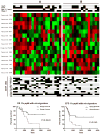Chromosomal and microRNA expression patterns reveal biologically distinct subgroups of 11q- neuroblastoma
- PMID: 20406844
- PMCID: PMC2880207
- DOI: 10.1158/1078-0432.CCR-09-3215
Chromosomal and microRNA expression patterns reveal biologically distinct subgroups of 11q- neuroblastoma
Abstract
Purpose: The purpose of this study was to further define the biology of the 11q- neuroblastoma tumor subgroup by the integration of array-based comparative genomic hybridization with microRNA (miRNA) expression profiling data to determine if improved patient stratification is possible.
Experimental design: A set of primary neuroblastoma (n = 160), which was broadly representative of all genetic subtypes, was analyzed by array-based comparative genomic hybridization and for the expression of 430 miRNAs. A 15-miRNA expression signature previously shown to be predictive of clinical outcome was used to analyze an independent cohort of 11q- tumors (n = 37).
Results: Loss of 4p and gain of 7q occurred at a significantly higher frequency in the 11q- tumors, further defining the genetic characteristics of this subtype. The 11q- tumors could be split into two subgroups using a miRNA expression survival signature that differed significantly in clinical outcome and the overall frequency of large-scale genomic imbalances, with the poor survival subgroup having significantly more imbalances. miRNAs from the expression signature, which were upregulated in unfavorable tumors, were predicted to target downregulated genes from a published mRNA expression classifier of clinical outcome at a higher-than-expected frequency, indicating the miRNAs might contribute to the regulation of genes within the signature.
Conclusion: We show that two distinct biological subtypes of neuroblastoma with loss of 11q occur, which differ in their miRNA expression profiles, frequency of segmental imbalances, and clinical outcome. A miRNA expression signature, combined with an analysis of segmental imbalances, provides greater prediction of event-free survival and overall survival outcomes than 11q status by itself, improving patient stratification.
Copyright 2010 AACR.
Figures


Comment in
-
Pediatric oncology: 11q negative neuroblastoma subgroups predict outcomes and may guide treatment.Nat Rev Clin Oncol. 2010 Aug;7(8):421. doi: 10.1038/nrclinonc.2010.110. Nat Rev Clin Oncol. 2010. PMID: 20700946 No abstract available.
Similar articles
-
Integrated genomic profiling identifies two distinct molecular subtypes with divergent outcome in neuroblastoma with loss of chromosome 11q.Oncogene. 2010 Feb 11;29(6):865-75. doi: 10.1038/onc.2009.390. Epub 2009 Nov 9. Oncogene. 2010. PMID: 19901960
-
Comparative genomic hybridization (CGH) analysis of stage 4 neuroblastoma reveals high frequency of 11q deletion in tumors lacking MYCN amplification.Int J Cancer. 2001 Mar 1;91(5):680-6. doi: 10.1002/1097-0215(200002)9999:9999<::aid-ijc1114>3.0.co;2-r. Int J Cancer. 2001. PMID: 11267980
-
Oligonucleotide microarray analysis of gene expression in neuroblastoma displaying loss of chromosome 11q.Carcinogenesis. 2004 Sep;25(9):1599-609. doi: 10.1093/carcin/bgh173. Epub 2004 Apr 16. Carcinogenesis. 2004. PMID: 15090470 Review.
-
Are gains of chromosomal regions 7q and 11p important abnormalities in neuroblastoma?Cancer Genet Cytogenet. 2003 Jan 15;140(2):133-7. doi: 10.1016/s0165-4608(02)00681-7. Cancer Genet Cytogenet. 2003. PMID: 12645651
-
11q deletion in neuroblastoma: a review of biological and clinical implications.Mol Cancer. 2017 Jun 29;16(1):114. doi: 10.1186/s12943-017-0686-8. Mol Cancer. 2017. PMID: 28662712 Free PMC article. Review.
Cited by
-
Comparative genetic study of intratumoral heterogenous MYCN amplified neuroblastoma versus aggressive genetic profile neuroblastic tumors.Oncogene. 2016 Mar 17;35(11):1423-32. doi: 10.1038/onc.2015.200. Epub 2015 Jun 29. Oncogene. 2016. PMID: 26119945
-
Transcriptional changes induced by the tumor dormancy-associated microRNA-190.Transcription. 2013 Jul-Aug;4(4):177-91. doi: 10.4161/trns.25558. Epub 2013 Jul 1. Transcription. 2013. PMID: 23863200 Free PMC article.
-
FOXP1 inhibits cell growth and attenuates tumorigenicity of neuroblastoma.BMC Cancer. 2014 Nov 18;14:840. doi: 10.1186/1471-2407-14-840. BMC Cancer. 2014. PMID: 25406647 Free PMC article.
-
ERBB3 is a marker of a ganglioneuroblastoma/ganglioneuroma-like expression profile in neuroblastic tumours.Mol Cancer. 2013 Jul 8;12(1):70. doi: 10.1186/1476-4598-12-70. Mol Cancer. 2013. PMID: 23835063 Free PMC article.
-
miRNA expression profiling of the murine TH-MYCN neuroblastoma model reveals similarities with human tumors and identifies novel candidate miRNAs.PLoS One. 2011;6(12):e28356. doi: 10.1371/journal.pone.0028356. Epub 2011 Dec 2. PLoS One. 2011. PMID: 22164278 Free PMC article.
References
-
- Brodeur GM. Neuroblastoma: biological insights into a clinical enigma. Nat Rev Cancer. 2003;3:203–16. - PubMed
-
- Brodeur GM, Seeger RC, Schwab M, Varmus HE, Bishop JM. Amplification of N-myc in untreated human neuroblastomas correlates with advanced disease stage. Science. 1984;224:1121–4. - PubMed
-
- Van Roy N, Laureys G, Cheng NC, et al. 1;17 translocations and other chromosome 17 rearrangements in human primary neuroblastoma tumors and cell lines. Genes Chromosomes Cancer. 1994;10:103–14. - PubMed
-
- Guo C, White PS, Weiss MJ, et al. Allelic deletion at 11q23 is common in MYCN single copy neuroblastomas. Oncogene. 1999;18:4948–57. - PubMed
-
- Plantaz D, Vandesompele J, Van Roy N, et al. Comparative genomic hybridization (CGH) analysis of stage 4 neuroblastoma reveals high frequency of 11q deletion in tumors lacking MYCN amplification. Int J Cancer. 2001;91:680–6. - PubMed
Publication types
MeSH terms
Substances
Grants and funding
LinkOut - more resources
Full Text Sources
Other Literature Sources
Medical

